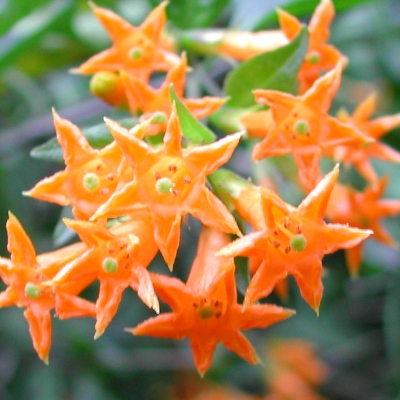| Home |
Strange Wonderful Things Rare and exotic plants |
 |
|---|
Mango Cestrum
Cestrum aurantiacum
Please be careful removing your plant from it's packaging.
Getting started -- Your plant was grown in filtered light, not direct sun, so it should be acclimated to direct sun slowly. I recommend starting your plant in a 1-2 gallon pot, so you can slowly move it from shade to sun over a period of a few weeks. Start by giving it filtered sun for the first week, and then increase the sun by an hour or two every week.
Soil -- The Mango Cestrum likes soil that's high in organic matter (compost) but that also drains well. Most high-quality potting soils should work, although it helps to add 1 part perlite or sand for each 2-3 parts potting soil. You may use garden soil eventually, but i would use potting soil for the first couple of months.
Transplant carefully - Before removing your plant from its pot, give it a watering if the soil feels dry, so it doesn't break apart, which can damage the roots. If you have trouble removing the plant, push the eraser end of a pencil into the holes at the bottom to loosen it.
Watering -- For the first month, ensure that the original soil ball remains moist (but not soggy). Don't allow the soil to dry out. I recommend using a moisture meter probe, which you can buy at garden shops for about $5. You simply stick the probe down to the root level and read the dial. Water when the needle is 1/3 to 1/2 across the dial. This plant can handle dry spells fairly well, however it is best to not let it dry out.
Planting out -- Once your plant has grown a foot, it can be planted out in the ground. If you're going to keep it in a container, repot to a 3-5 gallon pot whenever the roots reach the bottom of the container, or after 2 months. Repot again to a larger pot when it becomes root bound. The size of the final pot depends on how large you choose to let it grow. A full-sized bush should have 40 or more gallons, although a small plant can be kept in a 5 gallon pot.
Climate - This Cestrum is said to handle down to 25-30 degrees F, and possibly lower. It doesn't freeze here in San Francisco, so i don't know it's cold tolerance. It grows best when protected from all frost. It likes part- to full-sun. In hot areas, it will enjoy some mid-day shade during the hottest part of the day. In colder areas, mulch the base well in case it should be struck down by frost. New growth will probably emerge from beneath the mulch. You may grow your plant indoors, provided that the air isn't too dry. Indoors, it flowers throughout the year for me!
Fertilizing -- During periods of active growth, give monthly feedings with ordinary vegetable fertilizer that contains micronutrients. Follow the label's recommended dosage carefully. It's normal for some of the older leaves to turn yellow and drop throughout the year, but if it's excessive, it could be from not enough fertilizer, particularly nitrogen. It could also be from inconsistent watering.
Pruning -- You may prune your plant at any time to shape it. To grow it tall and tree-shaped, cut away the side branches on the lower half of the stem. If you prefer a shorter, bushier plant, clip off the leading tip. Flowers appear on the ends of the new growth.
Propagation -- Cut a 5" branch tip, remove the leaves on the bottom half, and clip the remaining leaves in half or slightly more. Stick it in a pot of moist soil. Cover the pot with a clear plastic bag that has a couple of small holes punched in it. Put the pot in a bright but sun-free spot until it's rooted. A fluorescent bulb kept 6" away gives the right amount of light until it has roots.
Bugs to watch for -- Spider mites (tiny "dots" under the leaves), Aphids (green ones are hard to see), white mealy bugs, and scale (brown discs on the stem - hard to see!).
If you have any questions or problems, please email me.
Enjoy your plant!
Jeff
Strange Wonderful Things
| Home |
Strange Wonderful Things Rare and exotic plants |
|
|---|---|---|
| Entire site Copyright 2003-2023 by Strange Wonderful Things, except as noted | ||

